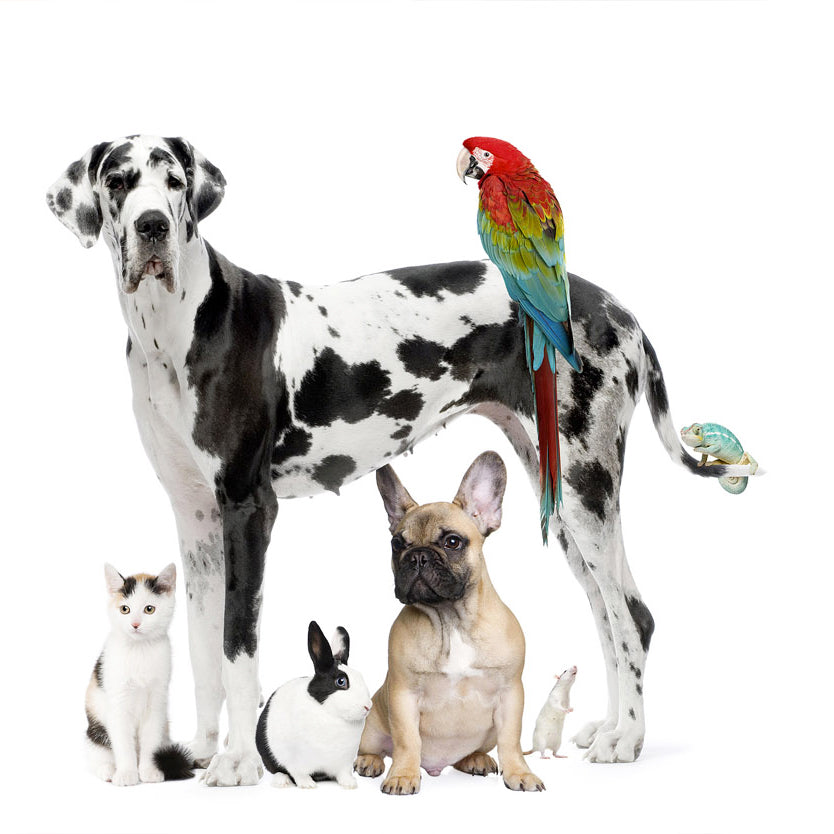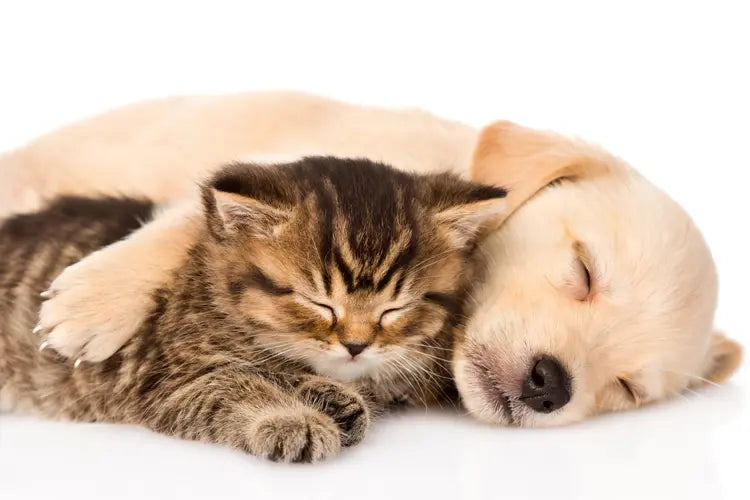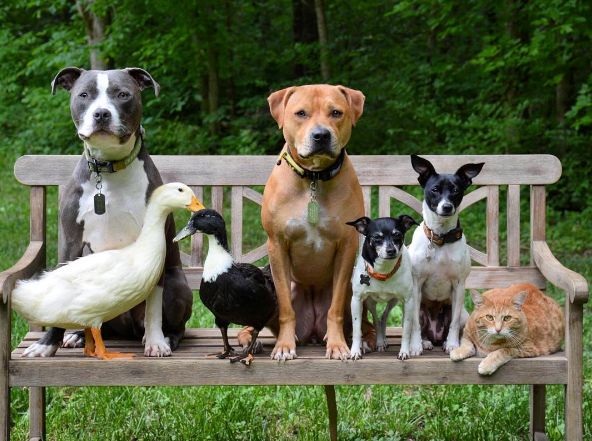
Tips on how to facilitate animals getting along with each other
Getting animals to get along with each other can require patience, understanding, and strategic intervention. Here are some tips to help facilitate harmony between your pets:
Pets Gradual Introduction to Co-Habituating
When introducing a new pet into the household or introducing existing pets to each other, do it gradually. Start with brief supervised interactions in a neutral territory, such as a room neither animal considers their own territory. Allow them to sniff and observe each other from a safe distance, gradually increasing their exposure to one another over time.
Positive Reinforcement
Encourage positive interactions between your pets by rewarding them with treats, praise, or playtime when they display calm and friendly behaviour towards each other. Positive reinforcement helps create positive associations and reinforces good behaviour.
Respect Individual Space
Ensure each pet has their own space within the home where they can retreat to if they feel stressed or overwhelmed. This could be a separate room, a cosy bed, or a designated area where they feel safe and secure.
Establish Boundaries
Set clear boundaries and rules for behaviour, and consistently enforce them with both pets. This may include rules about sharing toys, food, and sleeping areas. Consistency is key to helping pets understand what is expected of them.
Supervised Interaction
Always supervise interactions between your pets, especially in the initial stages of their relationship. Be prepared to intervene if tensions escalate or if one pet becomes overly aggressive or fearful.
Provide Adequate Resources
Ensure that there are plenty of resources, such as food bowls, water bowls, litter boxes (if applicable), toys, and resting areas, to prevent competition and reduce potential sources of conflict.
Regular Exercise and Stimulation
Provide regular exercise and mental stimulation for your pets to help alleviate boredom and excess energy, which can sometimes manifest as aggressive behaviour. Engage them in interactive play sessions and provide enrichment activities to keep them mentally and physically stimulated.
Seek Professional Help
If despite your best efforts, your pets continue to struggle to get along, consider seeking the assistance of a professional animal behaviourist or trainer. They can provide personalised advice and guidance based on your specific situation and help you implement effective strategies to improve the relationship between your pets.

Examples of common household pets habituation and learning to live together
Many combinations of pets can live together happily under the right circumstances. Here are some examples:
Dogs and Cats
Despite the common belief that dogs, and cats are natural enemies, many dogs and cats can form strong bonds and live harmoniously together. It often depends on the individual personalities of the animals involved and their early socialisation experiences.
Dogs and Rabbits
With proper introductions and supervision, dogs and rabbits can cohabitate peacefully. Some larger breeds of dogs may have a higher prey drive, so it's essential to choose a dog that is calm and gentle around smaller animals.
Cats and Rabbits
Cats and rabbits can also live together successfully, especially if they are introduced to each other at a young age. Providing separate spaces for each pet to retreat to and ensuring the rabbit has plenty of hiding spots can help reduce stress.
Dogs and Birds
While it may seem counterintuitive, many dogs and birds can live together without issues. However, caution should be exercised, especially with breeds known for their high prey drive. Birds should always be housed in a secure cage when the dog is unsupervised.
Dogs and Guinea Pigs
Some dogs can coexist peacefully with guinea pigs, especially if they have been raised with them from a young age. However, it's essential to supervise interactions closely, as some dogs may view guinea pigs as prey.
Dogs and Other Dogs
Dogs are naturally social animals and often enjoy the company of other dogs. However, successful cohabitation depends on factors such as compatibility, temperament, and proper introductions. It's essential to match dogs based on size, energy level, and play style.
Cats and Other Cats
Cats are typically solitary animals, but many can live happily with other cats, especially if they are introduced gradually and given plenty of space and resources. Providing multiple litter boxes, food bowls, and vertical spaces can help prevent conflict.
Small Mammals (e.g., Hamsters, Gerbils) and Other Small Mammals
Small mammals of the same species can often live together happily if they are introduced at a young age and housed in a large enough enclosure with plenty of resources. However, it's essential to research each species' social dynamics and compatibility before attempting to house them together.
Fish and Other Fish
Fish are relatively low-maintenance pets that can live together peacefully in a well-maintained aquarium. However, it's crucial to research each species' compatibility regarding water parameters, temperament, and territorial behaviour.
What pets don’t live together happily?
While many combinations of pets can coexist peacefully with proper introductions and management, there are some combinations that may not live together happily due to inherent differences in their behaviours, needs, or natural instincts. Here are some examples:
Predators and Prey
Pets with predatory instincts, such as dogs, cats, ferrets, or birds of prey, may not live harmoniously with small animals that they perceive as prey, such as rodents (e.g., mice, rats, hamsters), birds, or fish. Even with supervision, the risk of injury or death to the smaller pet is significant.
Territorial Animals
Some pets are naturally territorial and may not tolerate the presence of other animals in their space. This includes certain species of birds, reptiles (e.g., some species of lizards and snakes), and small mammals (e.g., Syrian hamsters). Attempting to house these animals together can lead to stress, aggression, and injury.
Social Hierarchies
Certain species have complex social structures and hierarchies that can lead to conflict when housed with other animals. For example, keeping multiple male betta fish together (known as betta splendens) can result in aggression and fighting, as these fish are territorial and often solitary in nature.
Species with Different Environmental Needs
Pets with vastly different environmental requirements may not thrive when housed together. For example, reptiles that require specific temperature, humidity, and lighting conditions may not do well if housed with pets that have different environmental needs, such as mammals or birds.
Aggressive or Territorial Dogs
Some dogs have a strong prey drive, aggressive tendencies, or territorial behaviours that make them incompatible with other pets. Breeds known for their high prey drive, such as certain terriers or sighthounds, may pose a risk to smaller animals, including cats, rabbits, or small mammals.
Incompatible Social Dynamics
Certain species have social dynamics that are not conducive to living with other animals. For example, some species of birds, such as African Grey Parrots or Macaws, may form strong bonds with their human caregivers but may become aggressive or territorial towards other pets in the household.
Stress-sensitive Species
Some pets are particularly sensitive to changes in their environment or the presence of unfamiliar animals, which can lead to stress-related health issues. For example, certain species of fish or reptiles may become stressed or exhibit abnormal behaviours when housed with other animals.
Conclusion
Remember that every pet is unique, and it may take time for them to adjust to each other's presence. With patience, consistency, and a proactive approach, many pets can learn to coexist peacefully and even develop strong bonds with each other over time.
Additionally, understanding each species' natural behaviours and social dynamics can help prevent potential conflicts and promote positive interactions.



